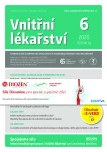Myocardial infarction or broken heart syndrome?
Authors:
Vojtěch Brázdil; Martin Hudec; Martin Poloczek; Jan Kaňovský; Roman Štípal; Petr Jeřábek; Otakar Boček; Petr Kala
Authors‘ workplace:
Interní kardiologická klinika LF MU a FN Brno, pracoviště Bohunice
Published in:
Vnitř Lék 2020; 66(6): 378-380
Category:
Case Report
Overview
Takotsubo or broken heart syndrome represents a rare type of cardiomyopathy, often imitating acute myocardial infarction. It is a sudden transient cardiac syndrome that typically involves left ventricular apical akinesis with preserved motility of basal heart segments. In contrast to acute myocardial infarction, the pathology is fully reversible in the majority of patients. In the present case‑report, we discuss 78‑years‑old female referred to our department for typical symptomatology of acute myocardial infarction. Coronary angiography revealed significant stenosis on the left anterior descending coronary artery, but ventriculography disclosed apical dysfunction and clinical course of the disease result in the diagnosis of Takotsubo cardiomyopathy. Until recently, normal or non‑obstructive coronary angiography represented one of the mean diagnostic features of Takotsubo cardiomyopathy. In 2018, new diagnostic criteria were introduced, importantly modifying our approach to the Takotsubo diagnostics with omitting a coronary lesion as an exclusion criterium of the Takotsubo cardiomyopathy.
Keywords:
acute myocardial infarction – InterTAK Diagnostic criteria – Takotsubo cardiomyopathy
Sources
1. Sato H, Tateishi H, Uchida T. Takotsubo ‑type cardiomyopathy due to multivessel spasm. 1990.
2. Bybee KA, Prasad A. Stress ‑Related Cardiomyopathy Syndromes. Circulation 2008; 118: 397–409.
3. Gili S, et al. Cardiac arrest in takotsubo syndrome: results from the InterTAK Registry. Eur Heart J 2019; 40: 2142–2151.
4. Akashi YJ, Goldstein DS, Barbaro G, et al. Takotsubo Cardiomyopathy: A New Form of Acute, Reversible Heart Failure. Circulation 2008; 118: 2754–2762.
5. Hassan SY, Tornvall P. Epidemiology, pathogenesis, and management of takotsubo syn‑ drome. Clin Auton Res 2018; 28: 53–65.
6. Ghadri JR et al. International Expert Consensus Document on Takotsubo Syndrome (Part II): Diagnostic Workup, Outcome, and Management. Eur Heart J 2018; 39: 2047–2062.
7. Bybee KA, et al. Systematic Review: Transient Left Ventricular Apical Ballooning: A Syndrome That Mimics ST ‑Segment Elevation Myocardial Infarction. Ann Intern Med 2004; 141: 858–865.
8. Ghadri JR, et al. International Expert Consensus Document on Takotsubo Syndrome (Part I): Clinical Characteristics, Diagnostic Criteria, and Pathophysiology. Eur Heart J 2018; 39: 2032–2046.
9. Kurisu S, et al. Prevalence of incidental coronary artery disease in tako ‑tsubo cardiomyopathy. Coron Artery Dis 2009; 20: 155–158.
10. Zeb M, Sambu N, Scott P, et al. Takotsubo cardiomyopathy: a diagnostic challenge. Postgrad Med J 2001; 87: 51.
11. Thiele H, Barbato E, Barthelemy O, Bauersachs J, Bhatt DL. 2020 ESC Guidelines for the management of acute coronary syndromes in patients presenting without persistent ST‑segment elevation: 79.
12. Ghadri JR, Cammann VL, Templin C. The International Takotsubo Registry. Heart Fail Clin 2016; 12: 597–603.
Labels
Diabetology Endocrinology Internal medicineArticle was published in
Internal Medicine

2020 Issue 6
Most read in this issue
- Gastrointestinal tract involvement in mixed connective tissue disease (Sharp syndrome)
- Myocardial infarction or broken heart syndrome?
- Food allergy and intolerance
- Complement deficiencies
